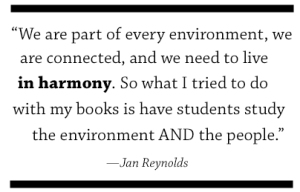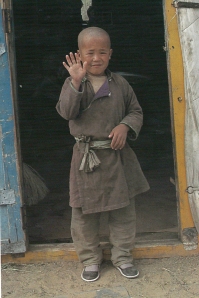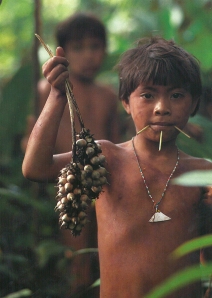 Jan Reynolds is a writer, photographer, and adventurer who has written over fourteen nonfiction books for children about her travels. Her work has appeared in numerous publications including National Geographic, The New York Times, and Outside Magazine. Reynolds is an avid skier, mountain climber, and adventurer who held the record for women’s high altitude skiing, was part of the first expedition to circumnavigate Mount Everest, and performed a solo crossing of the Himalayas.
Jan Reynolds is a writer, photographer, and adventurer who has written over fourteen nonfiction books for children about her travels. Her work has appeared in numerous publications including National Geographic, The New York Times, and Outside Magazine. Reynolds is an avid skier, mountain climber, and adventurer who held the record for women’s high altitude skiing, was part of the first expedition to circumnavigate Mount Everest, and performed a solo crossing of the Himalayas.
You are a world-class adventurer and athlete in addition to being a children’s author. Were you always a writer, or were you inspired to begin writing by your travels?
I’ve always been a writer…. I had a short story, fiction, that was published when I was in high school. I’m working on a young adult fiction book right now!
What was your hardest trip or exploration? Was there ever a moment in your travels when you wanted to turn back? What inspired you to keep going?
When I was crossing the Himalaya solo, I almost turned back, I was so sick (I talk about this in my documentary video, “Cultural Adventure with Jan Reynolds”). I lived in my tent alone for about four days and nights, and was found by a Sherpa and his son who nursed me back to health, and I finished my journey going from Nepal into Tibet over the Himalaya following the salt trade. I kept going because I needed to complete my trade on this salt trade route. I was working for National Geographic magazine, and I wanted to get my story!!
Your books, especially your Vanishing Cultures series, chronicle the time you spent with endangered indigenous groups around the world. Since those books were published, have you gone back to visit any of the communities you connected with? Do you know how they’re doing?
I’ve been back to visit many of the places in my Vanishing Cultures series, and what I’ve found is that they are vanishing in terms of their traditional lives. The young are looking for jobs in the cities and towns nearby. It isn’t possible to make a living traditionally. For example trucks and planes are much faster crossing the Sahara than a camel, so camel caravans cannot make profitable trades anymore.
Many of the groups about which you’ve written have a history of being exploited by outsiders. How do you first approach them about doing a project? How do you build trust with the community?
When I visited these people it was a matter of me just showing up. So approaching them was literally just being there, it was so far out in most cases, they were just curious about me, that was my approach! I built trust by making one really good friend, and they became my mentor and guardian of sorts, and I always traveled as a trader with trade goods, silk, wool scarves, gold and silver jewelry, that opened doors too.
It is not always easy to get people to “act natural” in front of a camera, especially people who are not often photographed. How do you get your subjects comfortable in front of your camera? What do you do to ensure that your presence as a photographer does not change their behavior?
I dress like the locals as much as I can so that when they look at me behind the camera they aren’t having funny expressions! I also hang out with people quite a while before I start shooting so they are comfortable with me. I also give them a little snap shooter with a flash. Kids really love that, and they take pics of me, whether they know they are or not…. it’s like playing a game together. I try not to bring in things that are junky or techno, my trade items are things they know, and I try to blend in as much as I can so I’m not intrusive. I’m not there to teach or train, I’m just there to be, and record.
 Why do you think it’s important for a young reader from, say, Nebraska, to learn about a small indigenous culture from the Amazon Basin? What do you think are the big benefits of geo-literacy and global education?
Why do you think it’s important for a young reader from, say, Nebraska, to learn about a small indigenous culture from the Amazon Basin? What do you think are the big benefits of geo-literacy and global education?
I think all kids need to know that all environments around the world have people in them, the Amazon had a thriving community of people throughout, before the Spanish explorers brought disease and killed the local Indians by the thousands. Now kids study plain environments, the rainforest, the desert, etc. without people in them, and it gives kids the wrong idea, that man and environments are separate.
We are part of every environment, we are connected, and we need to live in harmony. Man lived his daily life in all the environments on earth. We can still, we just need to be partners with the earth. So what I tried to do with my books is have students study the environment AND the people in that environment at the same time, that’s more normal….together, not separate.
What travel tips can you offer to young readers traveling abroad for the first time?
When you travel abroad, befriend a local, they are the doorway to understanding the people and the environment, and how they work together, through traditions, food, ceremonies, and so on.
Thanks for joining us, Jan! Feel free to leave further questions for Jan in the comments section below.
Further Reading:
Raising Global Citizens: Jan Reynolds Author Study
Where in the World: How One Class Used Google Maps to Explore the Vanishing Cultures Series
Beyond “Did You Know. . .”: Teaching Geo-Literacy Using the Vanishing Cultures Book Series
Filed under:
guest blogger Tagged:
environmentalism,
Himalaya,
informational text standards,
interview,
Jan Reynolds,
National Geographic,
nonfiction,
photography,
Travel,
vanishing cultures 

Jill Eisenberg, our Resident Literacy Expert, began her career teaching English as a Foreign Language to second through sixth graders in Yilan, Taiwan as a Fulbright Fellow. She went on to become a literacy teacher for third grade in San Jose, CA as a Teach for America corps member. She is certified in Project Glad instruction to promote English language acquisition and academic achievement. In her column she offers teaching and literacy tips for educators.
Eisenberg, our Resident Literacy Expert, began her career teaching English as a Foreign Language to second through sixth graders in Yilan, Taiwan as a Fulbright Fellow. She went on to become a literacy teacher for third grade in San Jose, CA as a Teach for America corps member. She is certified in Project Glad instruction to promote English language acquisition and academic achievement. In her column she offers teaching and literacy tips for educators.

Vanishing Cultures: Mongolia
Last week on the blog we spotlighted the work of Jan Reynolds, an author and explorer who has written nonfiction for young readers about cultures across the globe. If we had read the Vanishing Cultures series when I was a classroom teacher, my students would have been competing with each other over who knew the most outrageous fact. Did you know the Tiwi, an aboriginal tribe from an island off the coast of Australia, eat mangrove worms fresh? Did you know the Inuit from the Hudson Bay build rock piles that are stacked to look like men in order to scare caribou toward the real Inuit hunters?
My students loved to play the “did you know…” game. That became a popular sentence starter in our classroom. Students would scramble for the latest book or periodical on animals, prehistoric times, and exotic locales. The peregrine falcon, megalodon, and the giant panda were unshakable favorites.
Yet, we don’t want students to know “just facts” as if they are mini-encyclopedias. We aspire for our students to wonder and to investigate how our world works, how we are all connected to our environment and other humans halfway around the globe, and how our actions here affect others way over there.
The Common Core brings a refreshed spotlight to the nonfiction genre in children’s books, challenging publishers, educators, librarians, and parents to present children with high interest, high quality texts. What a time to engage students’ senses, sustain their wonder, and teach them geo-literacy!
National Geographic affirms, “with the rapid pace of change in the 21st century, it is more important than ever that young people understand the world around them.” It has adopted the concept of “geo-literacy,” and even gone so far as to create a community to support and cultivate “geo-educators.”

Vanishing Cultures: Himalaya
Enjoyed in classrooms around the nation, Jan Reynolds’ collection on at-risk traditional cultures is even more significant and striking today than when the series was first published. The persistent popularity of the Vanishing Cultures series speaks to its captivating power to make geo-literacy learning personal and tangible. This collection supports geo-literacy learning because each book challenges students to examine:
- the characteristics of each culture
- what makes this featured culture unique
- how this group of people has adapted to survive in its environment
- what challenges this group of people faces
- the modern human impact (positive and negative) on this traditional culture and the environment
- why the author would want to share this story with children and create a whole series on this topic
When we educate children about other cultures and geo-literacy more broadly, we are implanting the idea that we learn in order to make better, more informed decisions. Before our students become adults in positions of power, we want them to have practice in pausing and thinking how their choices to construct their community could disturb the environment of another community or animal species.
The Vanishing Cultures books encourage students to reason and reflect critically and deeply about how humans affect other humans and why we all benefit from diversity. As classrooms around the country can attest, Jan Reynolds’ books will not only spark enthusiasm that we hope ignites into lifelong careers and hobbies, but also conversation on what information we need to make decisions that will shape our and others’ health, environment, and well-being.

Vanishing Cultures: Down Under
Classroom Ideas for Comparing and Contrasting Between Vanishing Cultures Books and Teaching Geo-Literacy
(Reading Standards, Integration of Knowledge & Ideas, Strand 9)
(Writing Standards, Research to Build & Present Knowledge, Strand 7 and 9)
- How are these cultures similar and different from each other? What actions do these families take in both books to protect their ways of life?
- Compare how the challenges of each culture are similar or different.
- Compare how the children in each book demonstrate their pride in their culture. Why is it important for the children to feel proud of who they are and their way of life?
- What is the author’s purpose in starting each book with the parents telling their child a story from long ago? How does this affect the tone of and set the mood in the series? How does this opening support the central idea?
- After reading two or more of the Vanishing Cultures books, what common features or characteristics does a Vanishing Culture book have? If you were to write a book about your family’s culture, what kinds of things happen in a Vanishing Cultures book? What are some things that will not happen in a Vanishing Cultures book? What central ideas and lessons will be in the book?
- Have students create a chart to compare different aspects of life across two or more cultures. Write the name of each cultural group being compared on the top of the chart, and list the topics for points of comparison down the left side. Here are some possible topics: Food, Clothing, Climate, Geography, Important Animals, Homes, How Children Help (Chores), Roles of Men & Women, Family Life, How People Have Fun, Beliefs, Means of Transportation, Challenges Faced Today, Celebrations, Honoring Loved Ones. Have students record appropriate information as they read and re-read the texts.
- One elementary class created the “Around the World with Jan Reynolds” project on Google Earth. Explore where each of the books takes place. Compare the political map with the satellite map. Reflect on how geography has helped or hurt the survival of these ancient cultures. Students can create their own maps of the different cultures at National Geographic’s MapMaker’s 1-Page Maps.
Filed under:
Curriculum Corner Tagged:
CCSS,
children's books,
close reading,
common core standards,
diversity,
Educators,
ELA common core standards,
environmentalism,
geography,
geoliteracy,
guided reading,
Multiracial,
Reading Aloud,
reading comprehension,
vanishing cultures 

 Jan Reynolds is a writer, photographer, and adventurer who has written over fourteen nonfiction books for children about her travels. Her work has appeared in numerous publications including National Geographic, The New York Times, and Outside Magazine. Reynolds is an avid skier, mountain climber, and adventurer who held the record for women’s high altitude skiing, was part of the first expedition to circumnavigate Mount Everest, and performed a solo crossing of the Himalayas.
Jan Reynolds is a writer, photographer, and adventurer who has written over fourteen nonfiction books for children about her travels. Her work has appeared in numerous publications including National Geographic, The New York Times, and Outside Magazine. Reynolds is an avid skier, mountain climber, and adventurer who held the record for women’s high altitude skiing, was part of the first expedition to circumnavigate Mount Everest, and performed a solo crossing of the Himalayas.

 Why do you think it’s important for a young reader from, say, Nebraska, to learn about a small indigenous culture from the Amazon Basin? What do you think are the big benefits of geo-literacy and global education?
Why do you think it’s important for a young reader from, say, Nebraska, to learn about a small indigenous culture from the Amazon Basin? What do you think are the big benefits of geo-literacy and global education?





